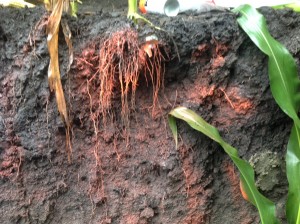As harvest comes to a close in many areas of the cornbelt, growers continue to evaluate what they have seen on the yield monitor. Many growers are developing conclusions on the practices that were used in 2014 that they feel most positively influenced their operation. The evaluation of 2014 leads to more structure to the 2015 plan as we evaluate challenges and opportunities.
One challenge with many growers is the condition of fields due to wet soil conditions. While harvesting this 2014 crop, we need to consider the lasting effect it will have in 2015. In many cases, as you see in the picture, water has continued to stand in ruts. Fall tillage is at a minimum in many areas due to high soil moisture and the inability to fracture the soil compaction. Compaction plays the key role in limited root growth, water infiltration, yield potential and overall soil health.
As we process best management practices for our fields, especially as many of us face compaction issues this year, let’s take a look at key basic principles of soil and healthy rooting environments for maximum nutrient and water uptake – leading to maximum yield potential.

Soil balance is key for a root system to maximize its footprint and microbial functions.
When looking at soil structure, there is a balance between mineral, water, air and OM. Key percentages to aim for in soil is 25% Air – 25% Water – 45% Mineral – 5% OM. Compaction leads to the loss of pore space between soil particles and occurs when that space is squeezed out of the soil and appears somewhere else. In heavily compacted soils, air is the limiting factor. Having limited air slows microbial functions, root development, and the availability for a root to uptake necessary nutrients.
Water infiltration allows roots to extend throughout the soil and gather needed nutrients.
Water infiltration is very important as it allows soils to move water through the root profile – minimizing ponding and allowing for early planting into a more desirable environment. The corn root desires to build infrastructure to meet the needs of the corn plant. In many ways the root system plays the role of the human heart. The root system webs its way through the soil in search for 13+ key nutrients and water the plant needs and pumps it into the plant daily to reach maximum yield potential. The root system shown in the picture, due to the proper rooting environment, has had the ability to reach through the soil to gather nutrients and water for the plant. (As a visual, the root system was sprayed with orange paint.)
Despite compaction issues, there are many management options to consider in 2015.
As we look to 2015, in many areas we will need to manage compaction. The fall was wet and the true need to get the crop out was a must. First, if soil moisture dries, fall tillage is a good option. The key to tillage is to fracture the compaction layer. Spring tillage rarely gives us a window to minimize compaction – in most observations, deep spring tillage can lead to additional compaction. Therefore, if fall conditions become favorable, that is your best option. Secondly, consider hybrid selection. On farms that compaction is a concern, look for hybrids that have a root system that more likely has the ability to penetrate tight soil along with the disease prevention and high yield characteristics you desire. Finally, make sure you have a plan to monitor those fields through the 2015 growing season. It is important to gauge root development and root health. Dig up roots and look for areas of restriction or concern. Gauge the plant and yield potential to make sure the roots have the ability to uptake necessary nutrients.